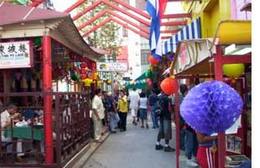Big change in little Chinatown
- Submitted by: admin
- Asia
- Culture and Traditions
- 07 / 13 / 2010

Associated Press. HAVANA (AP) — Chinatown has its own newspaper,the language of the four-page broadsheet Kwong Wah Po is Chinese, and its press is an antique, for the island's tiny Chinese community in general.
The paper, whose name means "Shine China," appears a few times a year, and 77-year-old Guillermo Chiu is the only person in Cuba who knows how to set the type on the 110-year-old printing press. A 300-word article can take him five hours to lay out.
"Soon this will be a museum," Chiu said, surveying the 6,000 tiny lead plates — each with a single Chinese character — which he places by hand. "The future won't be like this."
Perhaps, but there may be clues to the Cuba of tomorrow in the unique autonomy given the paper. Its articles, are mostly translated from the state-run media, it is edited and produced independently, and that leeway has granted Cuba's Chinese community to help preserve its dwindling cultural heritage.
On one freewheeling street in Havana's Chinatown, privately run restaurants offer chow mein and mojitos, and Chinese exchange students belt out karaoke.
"I think these kinds of initiatives hint at Cuba's near future — a path of reform within the current state structure," said Kathleen Lopez, a Rutgers University professor who has written on Cuba's Chinese community.
Havana's Chinatown was once one of Latin America's largest, with a population topping 50,000 and made up mostly of men from Guangdong province who began arriving in 1847 to labor on sugar plantations. They formed a community outside the city walls then ringing the capital — today's "Barrio Chino."
Their numbers peaked in the 1940s and early 50s. Today, Chiu is one of fewer than 150 native Chinese in Havana, mostly elderly Cantonese-speakers. But intermarriage has produced tens of thousands of Chinese-Cubans, Cuba and China are now allies, and 3,000 Chinese exchange students arrive annually to spend a year learning Spanish.
After the Soviet economic lifeline died and officials turned to developing tourism, they sought to make Cuba's Chinese culture an attraction. The state began allowing Chinese associations and social clubs to operate freely, and that freedom is felt along Calle Cuchillo — Knife Street — a pedestrian alley in the heart of Chinatown lined with Chinese restaurants.
The Knife Street restaurants rent their buildings from the city, "We have more freedom. We are privileged," said Roberto Vargas Lee, 44, manager of the Tien-Tan, a Knife Street favorite.
Founded by Vargas Lee's father-in-law after he moved to Cuba from Beijing, the Tien-Tan has two chefs from China. Its menu features 130 dishes.
A Havana native, Vargas Lee also teaches martial arts, which he studied in Beijing.
A few blocks from Knife Street, the Long Sai Li Society is one of 13 Chinese associations island-wide. The group has its own apartment building, restaurant and a room where Chinese sip tea and play mahjong under a mural of the Great Wall.
The Havana city historian's office has refurbished many crumbling buildings in Chinatown and a $324,000 restoration plan for Kwong Wah Po would preserve the printing press — built in 1900 by the National Paper and Type Company of New York — as a museum piece and provide modern equipment and a new office. Construction could begin by year's end.
Source: AP
Comments